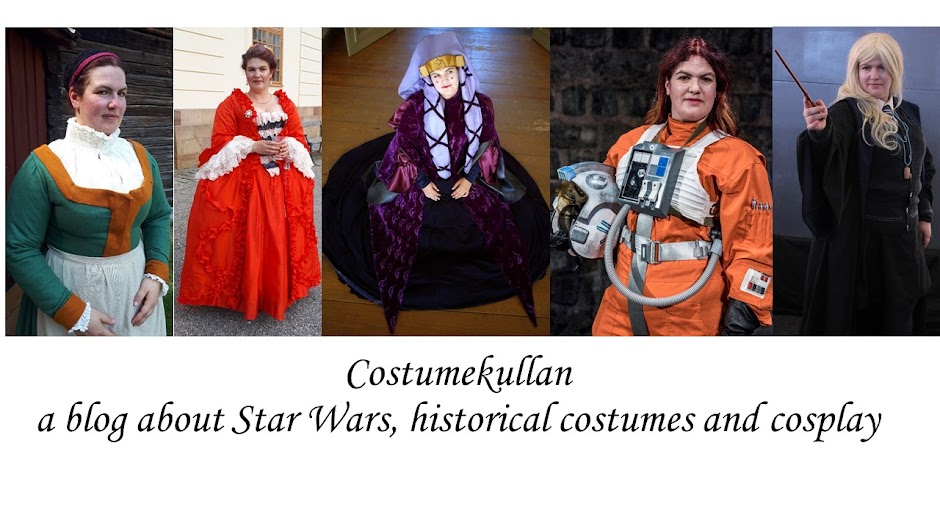The gollar is a garmen that covers the top of the bodice, from the neck down to the bust.
A lot of examples show it lined with fur, and with contrasting strips of fabric as decoration.
The main inspiration for this project was this tutorial on a fur-lined gollar from Handcrafted History.
I started with making a pattern from some scrap fabric.
I decided to make my gollar in two pieces, to make it easier to fit it. A gollar is not a full or semi-circle. My pattern started out as a circle, and then I folded and folded and folded away fabric until I had a pattern that fit. For an even better fit you could also make a shoulder seam, but I decided that a back seam was enough. It's important to mark out the grain line on the template, neither the center front nor the center back ended up on the grainline after my modifications.
I then cut out the gollar in one layer of wool and a layer in some kind of linen blend. It's an old fabric that looks quite like linen, but it doesn't feel like it so I guess I bought it before I was very accurate when it came to fabrics.
I sewed the center seam and added a straight strip of the wool fabric as a collar. At this point I also made and attached the threadcovered buttons and the button loops I talked about in an earlier post.
Then it was time for the fur. I don't have a trouble working with fur per se, as a meat eater it woud be hypocritical of me to not be able to work with all parts of an animal. I do not like the idea of breeding animals for the fur, in dreadful conditions though. For that reason I wouldn't buy new fur, unless I was sure that the animals had been treated well, but I don't have a problem reusing old furs, or wearing old fur. There are few things that are more comfortable on a cold winter than a fur.
My mother had a fur hat from my grandmother. It had both shrunk a bit and my mother's cats had found it and played with it. It wasn't usable as a hat anymore.
I took the hat and disassembled it. It consisted of a brim and a top.
The fur was quite fragile in places, where it had gone dry and brittle. Still I could cut the brim in two parts and when I had cut off the most damaged parts it was just enough to line the collar and the front edges with the fur.
I sewed the fur to the wool right side to right side and turned it. I couldn't press the fur, but I used my fingers to press the edges flat.
Then I sewed the linen lining and attached it securely to the seam allowance of the collar. I folded the fur to the back, sandwiching the linen lining between the fur and the wool along the neck and the front edges, and attached the fur to the lining.
This is the inside of the gollar, showing the shape and the lining.
It can also be worn unbuttoned, if I really want to show off the fur.
The making of the buttons and button loops have been documented here.
The Challenge: 4 buttons and fastening
Material: 0,5 m of red wool, 0,5 m of linen blend, 1 fur cap
Pattern: My own
Year: 1520s
Notions: Thread for the buttons and the button loops, linen thread to sew with
How historically accurate is it? 60%
Hours to complete: One day
First worn: -
Total cost: All the materials were from my stash or had been given to me, if bought new, except for the fur, I think around $20.













No comments:
Post a Comment